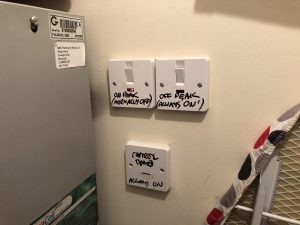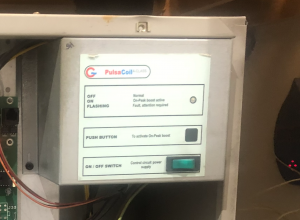Pulsacoils – puzzled by 3 switches on the wall?

A question I’m regularly asked is “What are the three switches on the wall next to a Pulsacoil for?” The reasons are complicated but I’ll try to simplify.
There are lots of versions of Pulsacoil. Some have two electrical supply cables while others have three.
For those with three cables, these being the Pulsacoil 3, Pulsacoil 2000, Pulsacoil ECO and Pulsacoil Stainless, the cables are as follows:
1) Cable one: A low cost off-peak electrical supply normally switched on and off automatically by the electricity company. Leave the wall switch ON all the time as the electricity company will turn the supply on at night and off during the day. This cable does the main work in heating hot water overnight, using ‘low cost’ night rate electricity. (‘Low cost’ means low, relative to the price of daytime electricity.)
2) Cable 2: A permanent daytime electrical supply for the electronic control board and pump. Keep this switch ON all the time too, so the pump can run when you turn a hot tap ON, and supply the hot water.
3) Cable 3: A permanent daytime electrical supply cable connected to the emergency backup electric immersion heater element. Keep this turned OFF normally. It is intended for you the user to turn ON if the off-peak heater fails, or if you have used up all the hot water heated the previous night and you need more hot water immediately. Turn it OFF after use or your electricity bills will be unnecessarily high.

For the A-Class, there will be only two cables. One cable is the off-peak cheap rate electrical supply which is normally switched on automatically at night and off during the day by the electricity company. The other is a permanent daytime electrical supply which runs the control board and the pump, Both switches on the wall need to be left ON all the time. This only applies to the Pulsacoil A-Class, which instead of a ‘Boost’ switch on the wall, has a ‘Boost’ button on the appliance control panel.
For versions of this appliance with two cables, these being the Pulsacoil Original and the Pulsacoil BP, (but NOT the Pulsacoil A-Class which works differently) there is no control board or pump. The two cables are as follows:
1) Cable 1: The low cost, off peak electrical supply to the main heater element. Leave with switch turned ON all the time as the electricity turns the supply on at night for you (and off during the day), so the heater uses only low cost night-time electricity to heat your water.
2) Cable 2: This is connected to the daytime back-up heater element for you to use if the main heater stops working, or if you need extra hot water. Keep it turned OFF normally and turn it ON only if you need emergency hot water. Turn it OFF after use or your bills will be higher than necessary.
For more information about Pulsacoils in general, check out my other posts in my blog section about them here.
Hope the above all helps but if it doesn’t, do post your questions in response! For more about Pulsacoils in general, I have a whole separate website all about them here: pulsacoil-repairs.co.uk
Mike

I just got my first electricity bill which is unusually high, because I left all three switches on the whole time. Now after reading your article, I have identified the night time off peaks switch, but I have no idea how to tell which one is cable 2 or 3. What’s the fastest way to test them out? Thanks you very much
Hi Heather.
To work out which is which, firstly turn both cables 2 and 3 switches OFF. Now go and check to confirm the HW no longer works at a hot tap.
Next, turn either one of those switches back on and check the hot tap again. Does hot water come from the tap again now? If hot water returns, then label the switch you turned ON as “Cable 2” for the pump and electronics, and the other switch will be cable 3 (Daytime boost).
And vice versa if still no hot water. Label that switch “Cable 3” Daytime boost, and the other switch “Cable 2”, pump and electronics.
Thanks Mike. I wish the boler engineers had spelt it out this succinctly.
Hiya, I have just received a 6k electricity bill for a 2 bed apartment. Just waiting to speak to someone, I think there may be a fault with my meter but I have had both switches on for my A class pulsacoil and worried that’s why? My landlord didn’t have a clue how they worked and I haven’t been using the timer. Please help?
Hi Emma. Apologies for missing your question when you first posted. No, the Pulsacoil A-Class needs both switches ON all the time. Unlike other versions of Pulsacoil it won’t be drawing large quantities of expensive daytime because on the A-Class there is a button which you the user need to press to turn on the “Boost” heater. Then once it’s heated, it will turn off automatically. Hope that helps, Mike
Hi, I’ve just moved into a flat with a Pulsacoil 2000 and the electricity bill for the first two weeks in my home shows 3x as much energy consumption than in my previous flat although I’ve barely been at home, this must be coming from the Pulsacoil… My landlord has told me to keep all the switches (I have only 2, main fuse and a power switch) ON all the time – would it be more cost effective to switch them off during the week when I’m not at home and just use the BOOST function in the morning and evening when I need hot water? Also, the flat doesn’t seem to have an Economy 7 electricity meter – does this mean I won’t be able to benefit from heating the water during off peak hours? Thanks very much in advance! Alexandra
Hi Mike
I have an issue with my Pulsacoil and the engineer cannot find the problem. Every night the pump starts running on and off and the noise is driving us mad. The timer and hot water are all good.
Regards
John